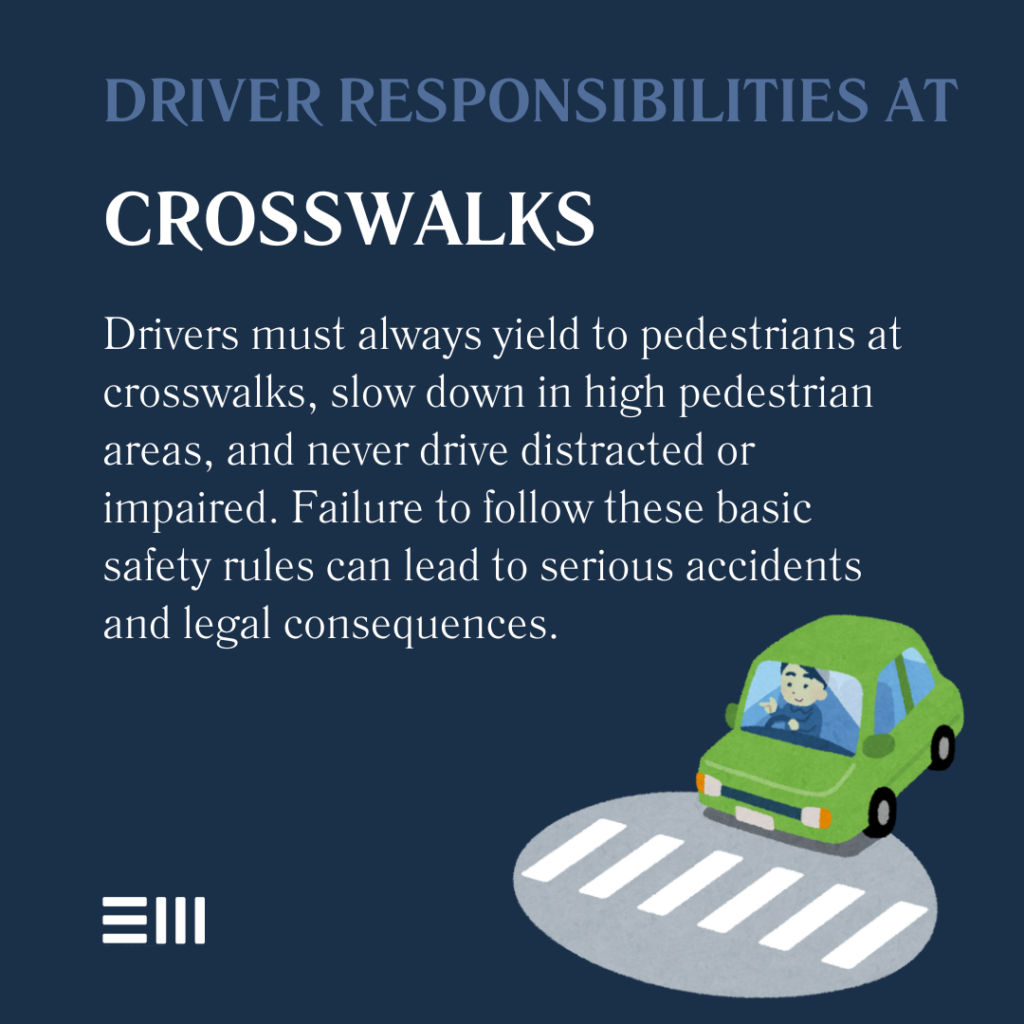
Every 88 minutes, a pedestrian loses their life in a traffic accident in the United States. In Alabama alone, pedestrian fatalities have increased by 46% over the past decade.
Behind these stark numbers lie stories of lives irreversibly changed in the brief moment it takes to cross a street.
What if a simple step could dramatically reduce these tragedies?
Common Causes of Pedestrian Accidents
Several factors contribute to pedestrian accidents in Alabama:
- Distracted driving;
- Failure to yield right-of-way;
- Speeding;
- Impaired driving;
- Poor visibility;
- Jaywalking; and
- Inadequate infrastructure.
Understanding these causes is the first step in preventing and determining liability when accidents occur.
Crosswalk Safety: Rights and Responsibilities
In Alabama, pedestrians have specific rights when using crosswalks:
- Right-of-way in marked crosswalks;
- Expectation of safe passage; and
- Protection under traffic laws.
However, these rights come with responsibilities, and pedestrians must also exercise due caution.
Driver Responsibilities at Crosswalks
Drivers in Alabama have clear responsibilities when approaching crosswalks:
- Yielding to pedestrians in marked crosswalks;
- Exercising extra caution in areas with high pedestrian traffic;
- Obeying posted speed limits and traffic signals; and
- Avoiding distracted driving.
Failure to meet these responsibilities can result in accidents and legal liability.

Crosswalk Types and Their Impact on Safety
Alabama features various types of crosswalks, each with unique safety considerations.
Understanding the differences between the types can help both pedestrians and drivers navigate them safely.
Marked Crosswalks
Marked crosswalks are designated by painted lines, textured surfaces, or different colored pavement.
Safety considerations:
- Increased visibility for drivers, especially in high-traffic areas;
- May create a false sense of security for pedestrians, leading to less cautious behavior;
- Require regular maintenance to ensure markings remain visible;
- Most effective when combined with other safety features like signage or pedestrian refuge islands; and
- In multi-lane roads, can pose risks if one lane of traffic stops but another doesn’t.
Unmarked Crosswalks
Unmarked crosswalks exist at intersections where sidewalks meet the street, even without visible markings.
Safety considerations:
- Less visible to drivers, requiring increased vigilance;
- Pedestrians may be unaware of their right to cross, leading to unpredictable behavior;
- Drivers may not expect pedestrians to cross at these locations;
- Can be safer in low-traffic residential areas where marked crosswalks might encourage unnecessary crossings; and
- Require public education to ensure both drivers and pedestrians understand the rules.
Mid-block Crosswalks
Mid-block crosswalks are marked crossings between intersections, often used in areas with high pedestrian activity.
Safety considerations:
- Can reduce jaywalking in areas with long distances between intersections;
- May surprise drivers who don’t expect crossings away from intersections;
- Often require additional safety features like pedestrian-activated signals or raised crosswalks;
- Most effective when placed in areas with good sight lines for both pedestrians and drivers; and
- Need clear signage to alert drivers of their presence.
Signalized Crosswalks
Signalized crosswalks use traffic signals or pedestrian-specific signals to control the flow of both vehicular and pedestrian traffic.
Safety considerations:
- Provide clear guidance for when pedestrians should cross;
- Can include features like countdown timers to help pedestrians judge crossing time;
- May lead to conflicts if pedestrians or drivers disregard signals;
- Require regular maintenance to ensure proper functioning;
- Can be enhanced with features like leading pedestrian intervals, giving pedestrians a head start before vehicles get a green light; and
- Need to be timed properly to allow sufficient crossing time for all pedestrians, including those with mobility challenges.
By understanding these different types of crosswalks and their unique safety considerations, both pedestrians and drivers can better navigate these crucial intersections of foot and vehicular traffic.
Legal Framework: Alabama Laws on Pedestrian Safety
Alabama has specific laws governing pedestrian safety and driver responsibility:
- Alabama Code § 32-5A-212: Pedestrians’ right-of-way in crosswalks;
- Alabama Code § 32-5A-213: Crossing at other than crosswalks; and
- Alabama Code § 32-5A-215: Drivers to exercise due care.
These laws form the foundation for determining rights, responsibilities, and potential liability in pedestrian accident cases.
When Accidents Occur: Steps to Take
If you’re involved in a pedestrian accident:
- Seek medical attention immediately;
- Report the accident to law enforcement;
- Gather information from the driver and witnesses;
- Document the scene if possible; and
- Avoid discussing fault at the scene.
By following these steps, you can protect your rights and ensure a smoother recovery process.
Driver Responsibilities Post-Accident
Drivers involved in a pedestrian accident should:
- Stop immediately and render aid;
- Call emergency services;
- Provide insurance and contact information;
- Cooperate with law enforcement; and
- Avoid admitting fault.
Taking responsibility and acting swiftly can make all the difference in mitigating the aftermath of the accident.
Gathering Evidence
Proper documentation is crucial for any potential legal proceedings:
- Police reports;
- Medical records;
- Witness statements;
- Surveillance footage; and
- Photographs of the scene and injuries.
This evidence can be vital in determining fault and securing compensation.
Liability in Pedestrian Accidents
Liability in pedestrian accidents isn’t always straightforward. Factors considered include:
- Adherence to traffic laws by both parties;
- Visibility conditions;
- Road design and maintenance; and
- Presence and condition of crosswalk markings.
Alabama’s contributory negligence law can significantly impact pedestrian accident cases, potentially barring recovery if the pedestrian is found even slightly at fault.
Potential Liable Parties
Beyond the driver, other parties may bear responsibility:
- Vehicle manufacturers (in cases of vehicle defects);
- Government entities (for poor road design or maintenance); and
- Property owners (for obstructed views).
Identifying all potentially liable parties is crucial for securing full compensation.
Preventing Pedestrian Accidents
Safety tips for pedestrians:
- Use designated crosswalks and pedestrian signals;
- Wear bright or reflective clothing at night;
- Avoid distractions while walking;
- Make eye contact with drivers before crossing; and
- Be especially cautious in parking lots and driveways.
By staying alert and following these guidelines, pedestrians can significantly reduce their risk of accidents.
Best practices for drivers:
- Always be prepared to stop at crosswalks;
- Reduce speed in areas with high pedestrian traffic;
- Check for pedestrians when turning;
- Avoid passing vehicles stopped at crosswalks; and
- Never drive under the influence of alcohol or drugs.
Practicing these habits helps drivers create a safer environment for everyone on the road.

Frequently Asked Questions About Pedestrian Accidents in Alabama
Pedestrian accidents can raise many questions about rights, responsibilities, and legal consequences.
Below are answers to some of the most frequently asked questions we receive about pedestrian accidents and crosswalk safety in Alabama.
Who Has the Right of Way at an Unmarked Crosswalk in Alabama?
In Alabama, pedestrians generally have the right of way at both marked and unmarked crosswalks.
However, pedestrians should exercise caution and not suddenly leave a curb or other place of safety and walk or run into the path of a vehicle which is so close as to constitute an immediate hazard.
Can a Pedestrian Be at Fault for an Accident in Alabama?
Yes, a pedestrian can be found at fault or partially at fault for an accident in Alabama. This could occur if the pedestrian jaywalked, crossed against a traffic signal, or was distracted (e.g., texting while walking).
It’s important to note that Alabama follows a contributory negligence rule, which means if a pedestrian is found even slightly at fault, they may be barred from recovering damages.
What Are the Penalties for Drivers Who Fail to Yield to Pedestrians in Crosswalks?
Drivers who fail to yield to pedestrians in crosswalks in Alabama can face traffic citations, fines, and points on their driving record.
In cases where this failure results in an accident, especially one causing injury or death, the driver may face more severe penalties, including criminal charges depending on the circumstances.
How Long Do I Have to File a Lawsuit After a Pedestrian Accident in Alabama?
In Alabama, the statute of limitations for personal injury cases, including pedestrian accidents, is generally two years from the date of the accident.
However, there can be exceptions to this rule, and it’s always best to consult with an attorney as soon as possible after an accident to ensure your rights are protected.
Are Drivers Always at Fault in Pedestrian Accidents?
No, drivers are not always at fault in pedestrian accidents. Fault is determined based on the specific circumstances of each case.
Factors such as whether the pedestrian was using a crosswalk, obeying traffic signals, and exercising due care are all considered. Both pedestrians and drivers have responsibilities to follow traffic laws and exercise caution.
What Should Drivers Do When Approaching a Crosswalk?
When approaching a crosswalk, drivers should slow down and be prepared to stop. They should scan for pedestrians on sidewalks or about to enter the crosswalk.
If a pedestrian is in the crosswalk, drivers must stop and allow them to cross safely. Drivers should also be aware that other vehicles stopping at a crosswalk may be yielding to a pedestrian they can’t see.
What Role Does Distracted Walking Play in Pedestrian Accidents?
Distracted walking, such as using a smartphone while crossing the street, can significantly increase the risk of pedestrian accidents.
While drivers bear a significant responsibility for pedestrian safety, pedestrians who are distracted may fail to notice oncoming vehicles or changes in traffic signals, potentially contributing to accidents.
Fight Harder, Fight Smarter
Pedestrian safety is a shared responsibility between those on foot and those behind the wheel. By understanding the laws, recognizing potential hazards, and committing to safe practices, we can all contribute to reducing pedestrian accidents in Alabama.
Whether you’re a pedestrian or a driver, staying informed and alert can make our streets safer for everyone.
Don’t let the statute of limitations expire in your case. Contact Baxley Maniscalco today for a free consultation.
Our compassionate attorneys are ready to listen to your story, explain your options, and guide you through every step of the legal process.
Can't find what you're looking for? Search our site below.










